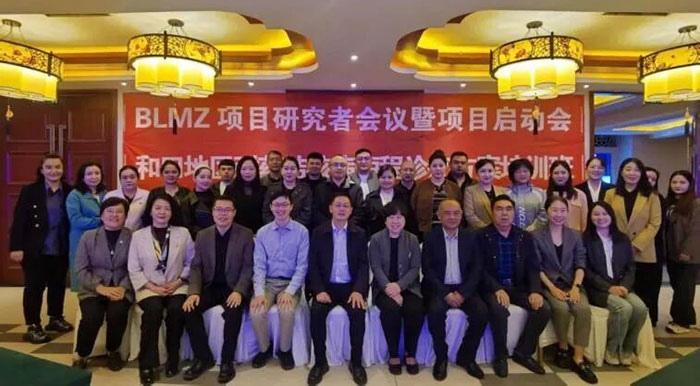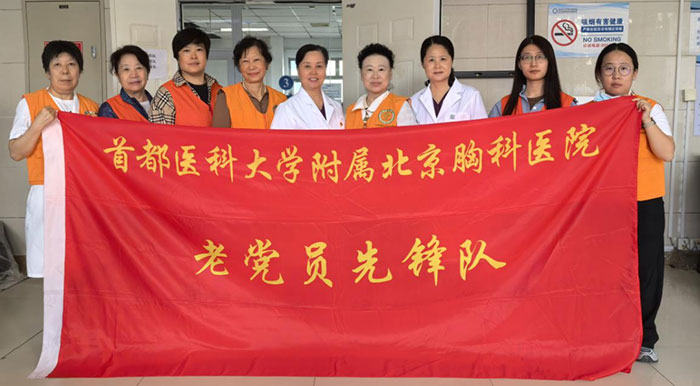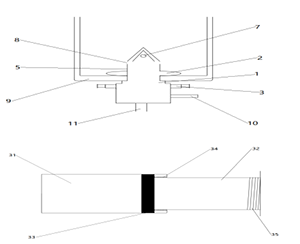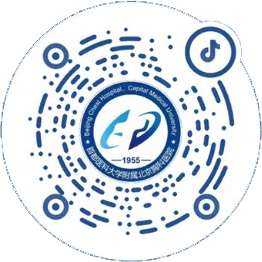2019年
No.10
Medical Abstracts
Keyword: lung cancer
1. Lancet. 2019 May 4;393(10183):1819-1830. doi: 10.1016/S0140-6736(18)32409-7. Epub 2019 Apr 4.
Pembrolizumab versus chemotherapy for previously untreated, PD-L1-expressing,
locally advanced or metastatic non-small-cell lung cancer (KEYNOTE-042): a
randomised, open-label, controlled, phase 3 trial.
Mok TSK(1), Wu YL(2), Kudaba I(3), Kowalski DM(4), Cho BC(5), Turna HZ(6), Castro
G Jr(7), Srimuninnimit V(8), Laktionov KK(9), Bondarenko I(10), Kubota K(11),
Lubiniecki GM(12), Zhang J(13), Kush D(12), Lopes G(14); KEYNOTE-042
Investigators.
Author information:
(1)Department of Clinical Oncology, State Key Laboratory of South China, Chinese
University of Hong Kong, Shatin, Hong Kong Special Administrative Region, China.
Electronic address: tony@clo.cuhk.edu.hk.
(2)Department of Pulmonary Oncology, Guangdong Lung Cancer Institute, Guangdong
General Hospital and Guangdong Academy of Medical Sciences, Guandong, China.
(3)Department of Internal Diseases, Riga East Clinical University-Latvian
Oncology Center, Riga, Latvia.
…
Comment in
Nat Rev Clin Oncol. 2019 Jul;16(7):403.
BACKGROUND: First-line pembrolizumab monotherapy improves overall and
progression-free survival in patients with untreated metastatic non-small-cell
lung cancer with a programmed death ligand 1 (PD-L1) tumour proportion score
(TPS) of 50% or greater. We investigated overall survival after treatment with
pembrolizumab monotherapy in patients with a PD-L1 TPS of 1% or greater.
METHODS: This randomised, open-label, phase 3 study was done in 213 medical
centres in 32 countries. Eligible patients were adults (≥18 years) with
previously untreated locally advanced or metastatic non-small-cell lung cancer
without a sensitising EGFR mutation or ALK translocation and with an Eastern
Cooperative Oncology Group (ECOG) performance status score of 0 or 1, life
expectancy 3 months or longer, and a PD-L1 TPS of 1% or greater. Randomisation
was computer generated, accessed via an interactive voice-response and integrated
web-response system, and stratified by region of enrolment (east Asia vs rest of
world), ECOG performance status score (0 vs 1), histology (squamous vs
non-squamous), and PD-L1 TPS (≥50% vs 1-49%). Enrolled patients were randomly
assigned 1:1 in blocks of four per stratum to receive pembrolizumab 200 mg every
3 weeks for up to 35 cycles or the investigator's choice of platinum-based
chemotherapy for four to six cycles. Primary endpoints were overall survival in
patients with a TPS of 50% or greater, 20% or greater, and 1% or greater
(one-sided significance thresholds, p=0·0122, p=0·0120, and p=0·0124,
respectively) in the intention-to-treat population, assessed sequentially if the
previous findings were significant. This study is registered at
ClinicalTrials.gov, number NCT02220894.
FINDINGS: From Dec 19, 2014, to March 6, 2017, 1274 patients (902 men, 372 women,
median age 63 years [IQR 57-69]) with a PD-L1 TPS of 1% or greater were allocated
to pembrolizumab (n=637) or chemotherapy (n=637) and included in the
intention-to-treat population. 599 (47%) had a TPS of 50% or greater and 818
patients (64%) had a TPS of 20% or greater. As of Feb 26, 2018, median follow-up
was 12·8 months. Overall survival was significantly longer in the pembrolizumab
group than in the chemotherapy group in all three TPS populations (≥50% hazard
ratio 0·69, 95% CI 0·56-0·85, p=0·0003; ≥20% 0·77, 0·64-0·92, p=0·0020, and ≥1% 0·81, 0·71-0·93, p=0·0018). The median surival values by TPS population were 20·0 months (95% CI 15·4-24·9) for pembrolizumab versus 12·2 months (10·4-14·2) for chemotherapy, 17·7 months (15·3-22·1) versus 13·0 months (11·6-15·3), and 16·7 months (13·9-19·7) versus 12·1 months (11·3-13·3), respectively. Treatment-related adverse events of grade 3 or worse occurred in 113 (18%) of 636
treated patients in the pembrolizumab group and in 252 (41%) of 615 in the chemotherapy group and led to death in 13 (2%) and 14 (2%) patients, respectively.
INTERPRETATION: The benefit-to-risk profile suggests that pembrolizumab
monotherapy can be extended as first-line therapy to patients with locally
advanced or metastatic non-small-cell lung cancer without sensitising EGFR or ALK
alterations and with low PD-L1 TPS.
FUNDING: Merck Sharp & Dohme.
Copyright © 2019 Elsevier Ltd. All rights reserved.
DOI: 10.1016/S0140-6736(18)32409-7
PMID: 30955977 [Indexed for MEDLINE]
2. Nat Rev Cancer. 2019 May;19(5):289-297. doi: 10.1038/s41568-019-0133-9.
Molecular subtypes of small cell lung cancer: a synthesis of human and mouse
model data.
Rudin CM(1), Poirier JT(2), Byers LA(3), Dive C(4), Dowlati A(5), George J(6),
Heymach JV(3), Johnson JE(7), Lehman JM(8), MacPherson D(9), Massion PP(8), Minna
JD(7), Oliver TG(10), Quaranta V(8), Sage J(11), Thomas RK(6), Vakoc CR(12),
Gazdar AF(7).
Author information:
(1)Memorial Sloan Kettering Cancer Center, New York, NY, USA. rudinc@mskcc.org.
(2)Memorial Sloan Kettering Cancer Center, New York, NY, USA. poirierj@mskcc.org.
(3)MD Anderson Cancer Center, Houston, TX, USA.
…
Erratum in
Nat Rev Cancer. 2019 Jun 7;:.
Small cell lung cancer (SCLC) is an exceptionally lethal malignancy for which
more effective therapies are urgently needed. Several lines of evidence, from
SCLC primary human tumours, patient-derived xenografts, cancer cell lines and
genetically engineered mouse models, appear to be converging on a new model of
SCLC subtypes defined by differential expression of four key transcription
regulators: achaete-scute homologue 1 (ASCL1; also known as ASH1), neurogenic
differentiation factor 1 (NeuroD1), yes-associated protein 1 (YAP1) and POU class
2 homeobox 3 (POU2F3). In this Perspectives article, we review and synthesize
these recent lines of evidence and propose a working nomenclature for SCLC
subtypes defined by relative expression of these four factors. Defining the
unique therapeutic vulnerabilities of these subtypes of SCLC should help to focus
and accelerate therapeutic research, leading to rationally targeted approaches
that may ultimately improve clinical outcomes for patients with this disease.
DOI: 10.1038/s41568-019-0133-9
PMCID: PMC6538259 [Available on 2020-05-01]
PMID: 30926931 [Indexed for MEDLINE]
3. Lancet Oncol. 2019 Jul;20(7):924-937. doi: 10.1016/S1470-2045(19)30167-6. Epub
2019 May 20.
Atezolizumab in combination with carboplatin plus nab-paclitaxel chemotherapy
compared with chemotherapy alone as first-line treatment for metastatic
non-squamous non-small-cell lung cancer (IMpower130): a multicentre, randomised,
open-label, phase 3 trial.
West H(1), McCleod M(2), Hussein M(3), Morabito A(4), Rittmeyer A(5), Conter
HJ(6), Kopp HG(7), Daniel D(8), McCune S(9), Mekhail T(10), Zer A(11), Reinmuth
N(12), Sadiq A(13), Sandler A(14), Lin W(15), Ochi Lohmann T(16), Archer V(17),
Wang L(18), Kowanetz M(19), Cappuzzo F(20).
Author information:
(1)Thoracic Oncology Program, Swedish Cancer Institute, Seattle, WA, USA.
(2)Sarah Cannon Research Institute, Florida Cancer Specialists, Fort Myers, FL,
USA.
(3)Sarah Cannon Research Institute, Florida Cancer Specialists, Leesburg, FL,
USA.
…
BACKGROUND: Atezolizumab (a monoclonal antibody against PD-L1), which restores
anticancer immunity, improved overall survival in patients with previously
treated non-small-cell lung cancer and also showed clinical benefit when combined
with chemotherapy as first-line treatment of non-small-cell lung cancer.
IMpower130 aimed to assess the efficacy and safety of atezolizumab plus
chemotherapy versus chemotherapy alone as first-line therapy for non-squamous
non-small-cell lung cancer.
METHODS: IMpower130 was a multicentre, randomised, open-label, phase 3 study done
in 131 centres across eight countries (the USA, Canada, Belgium, France, Germany,
Italy, Spain, and Israel). Eligible patients were aged 18 years or older, and had
histologically or cytologically confirmed stage IV non-squamous non-small-cell
lung cancer, an Eastern Cooperative Oncology Group performance status of 0 or 1,
and received no previous chemotherapy for stage IV disease. Patients were
randomly assigned (2:1; permuted block [block size of six] with an interactive
voice or web response system) to receive atezolizumab (1200 mg intravenously
every 3 weeks) plus chemotherapy (carboplatin [area under the curve 6 mg/mL per
min every 3 weeks] plus nab-paclitaxel [100 mg/m2 intravenously every week]) or
chemotherapy alone for four or six 21-day cycles followed by maintenance therapy.
Stratification factors were sex, baseline liver metastases, and PD-L1 tumour
expression. Co-primary endpoints were investigator-assessed progression-free
survival and overall survival in the intention-to-treat wild-type (ie, EGFRwt and
ALKwt) population. The safety population included patients who received at least
one dose of the study drug. This study is registered with ClinicalTrials.gov,
number NCT02367781.
FINDINGS: Between April 16, 2015, and Feb 13, 2017, 724 patients were randomly
assigned and 723 were included in the intention-to-treat population (one patient
died before randomisation, but was assigned to a treatment group; this patient
was excluded from the intention-to-treat population) of the atezolizumab plus
chemotherapy group (483 patients in the intention-to-treat population and 451
patients in the intention-to-treat wild-type population) or the chemotherapy
group (240 patients in the intention-to-treat population and 228 patients in the
intention-to-treat wild-type population). Median follow-up in the
intention-to-treat wild-type population was similar between groups (18·5 months
[IQR 15·2-23·6] in the atezolizumab plus chemotherapy group and 19·2 months
[15·4-23·0] in the chemotherapy group). In the intention-to-treat wild-type
population, there were significant improvements in median overall survival (18·6
months [95% CI 16·0-21·2] in the atezolizumab plus chemotherapy group and 13·9
months [12·0-18·7] in the chemotherapy group; stratified hazard ratio [HR] 0·79
[95% CI 0·64-0·98]; p=0·033) and median progression-free survival (7·0 months
[95% CI 6·2-7·3] in the atezolizumab plus chemotherapy group and 5·5 months
[4·4-5·9] in the chemotherapy group; stratified HR 0·64 [95% CI 0·54-0·77];
p<0·0001]). The most common grade 3 or worse treatment-related adverse events
were neutropenia (152 [32%] of 473 in the atezolizumab plus chemotherapy group vs
65 [28%] of 232 in the chemotherapy group), anaemia (138 [29%] vs 47 [20%]), and
decreased neutrophil count (57 [12%] vs 19 [8%]). Treatment-related serious
adverse events were reported in 112 (24%) of 473 patients in the atezolizumab
plus chemotherapy group and 30 (13%) of 232 patients in the chemotherapy group.
Treatment-related (any treatment) deaths occurred in eight (2%) of 473 patients
in the atezolizumab plus chemotherapy group and one (<1%) of 232 patients in the
chemotherapy group.
INTERPRETATION: IMpower130 showed a significant and clinically meaningful
improvement in overall survival and a significant improvement in progression-free
survival with atezolizumab plus chemotherapy versus chemotherapy as first-line
treatment of patients with stage IV non-squamous non-small-cell lung cancer and
no ALK or EGFR mutations. No new safety signals were identified. This study
supports the benefit of atezolizumab, in combination with platinum-based
chemotherapy, as first-line treatment of metastatic non-small-cell lung cancer.
FUNDING: F. Hoffmann-La Roche.
Copyright © 2019 Elsevier Ltd. All rights reserved.
DOI: 10.1016/S1470-2045(19)30167-6
PMID: 31122901
4. Nat Med. 2019 Jun;25(6):954-961. doi: 10.1038/s41591-019-0447-x. Epub 2019 May
20.
End-to-end lung cancer screening with three-dimensional deep learning on low-dose
chest computed tomography.
Ardila D(1), Kiraly AP(1), Bharadwaj S(1), Choi B(1), Reicher JJ(2), Peng L(1),
Tse D(3), Etemadi M(4), Ye W(1), Corrado G(1), Naidich DP(5), Shetty S(1).
Author information:
(1)Google AI, Mountain View, CA, USA.
(2)Stanford Health Care and Palo Alto Veterans Affairs, Palo Alto, CA, USA.
(3)Google AI, Mountain View, CA, USA. tsed@google.com.
(4)Northwestern Medicine, Chicago, IL, USA.
(5)New York University-Langone Medical Center, Center for Biological Imaging, New
York City, NY, USA.
Erratum in
Nat Med. 2019 Jun 28;:.
With an estimated 160,000 deaths in 2018, lung cancer is the most common cause of
cancer death in the United States1. Lung cancer screening using low-dose computed
tomography has been shown to reduce mortality by 20-43% and is now included in US
screening guidelines1-6. Existing challenges include inter-grader variability and
high false-positive and false-negative rates7-10. We propose a deep learning
algorithm that uses a patient's current and prior computed tomography volumes to
predict the risk of lung cancer. Our model achieves a state-of-the-art
performance (94.4% area under the curve) on 6,716 National Lung Cancer Screening
Trial cases, and performs similarly on an independent clinical validation set of
1,139 cases. We conducted two reader studies. When prior computed tomography
imaging was not available, our model outperformed all six radiologists with
absolute reductions of 11% in false positives and 5% in false negatives. Where
prior computed tomography imaging was available, the model performance was on-par
with the same radiologists. This creates an opportunity to optimize the screening
process via computer assistance and automation. While the vast majority of
patients remain unscreened, we show the potential for deep learning models to
increase the accuracy, consistency and adoption of lung cancer screening
worldwide.
DOI: 10.1038/s41591-019-0447-x
PMID: 31110349 [Indexed for MEDLINE]
5. Lancet Oncol. 2019 May;20(5):625-635. doi: 10.1016/S1470-2045(19)30035-X. Epub
2019 Apr 8.
Erlotinib plus bevacizumab versus erlotinib alone in patients with EGFR-positive
advanced non-squamous non-small-cell lung cancer (NEJ026): interim analysis of an
open-label, randomised, multicentre, phase 3 trial.
Saito H(1), Fukuhara T(2), Furuya N(3), Watanabe K(2), Sugawara S(4), Iwasawa
S(5), Tsunezuka Y(6), Yamaguchi O(7), Okada M(8), Yoshimori K(9), Nakachi I(10),
Gemma A(11), Azuma K(12), Kurimoto F(13), Tsubata Y(14), Fujita Y(15), Nagashima
H(16), Asai G(17), Watanabe S(18), Miyazaki M(19), Hagiwara K(20), Nukiwa T(21),
Morita S(22), Kobayashi K(7), Maemondo M(23).
Author information:
(1)Kanagawa Cancer Center, Yokohama, Japan.
(2)Miyagi Cancer Center, Natori, Japan.
(3)St Marianna University School of Medicine, Kawasaki, Japan.
…
BACKGROUND: Resistance to first-generation or second-generation EGFR tyrosine
kinase inhibitor (TKI) monotherapy develops in almost half of patients with
EGFR-positive non-small-cell lung cancer (NSCLC) after 1 year of treatment. The
JO25567 phase 2 trial comparing erlotinib plus bevacizumab combination therapy
with erlotinib monotherapy established the activity and manageable toxicity of
erlotinib plus bevacizumab in patients with NSCLC. We did a phase 3 trial to
validate the results of the JO25567 study and report here the results from the
preplanned interim analysis.
METHODS: In this prespecified interim analysis of the randomised, open-label,
phase 3 NEJ026 trial, we recruited patients with stage IIIB-IV disease or
recurrent, cytologically or histologically confirmed non-squamous NSCLC with
activating EGFR genomic aberrations from 69 centres across Japan. Eligible
patients were at least 20 years old, and had an Eastern Cooperative Oncology
Group performance status of 2 or lower, no previous chemotherapy for advanced
disease, and one or more measurable lesions based on Response Evaluation Criteria
in Solid Tumours (1.1). Patients were randomly assigned (1:1) to receive oral
erlotinib 150 mg per day plus intravenous bevacizumab 15 mg/kg once every 21
days, or erlotinib 150 mg per day monotherapy. Randomisation was done by
minimisation, stratified by sex, smoking status, clinical stage, and EGFR
mutation subtype. The primary endpoint was progression-free survival. This study
is ongoing; the data cutoff for this prespecified interim analysis was Sept 21,
2017. Efficacy was analysed in the modified intention-to-treat population, which
included all randomly assigned patients who received at least one dose of
treatment and had at least one response evaluation. Safety was analysed in all
patients who received at least one dose of study drug. The trial is registered
with the University Hospital Medical Information Network Clinical Trials
Registry, number UMIN000017069.
FINDINGS: Between June 3, 2015, and Aug 31, 2016, 228 patients were randomly
assigned to receive erlotinib plus bevacizumab (n=114) or erlotinib alone
(n=114). 112 patients in each group were evaluable for efficacy, and safety was
evaluated in 112 patients in the combination therapy group and 114 in the
monotherapy group. Median follow-up was 12·4 months (IQR 7·0-15·7). At the time
of interim analysis, median progression-free survival for patients in the
erlotinib plus bevacizumab group was 16·9 months (95% CI 14·2-21·0) compared with
13·3 months (11·1-15·3) for patients in the erlotinib group (hazard ratio 0·605,
95% CI 0·417-0·877; p=0·016). 98 (88%) of 112 patients in the erlotinib plus
bevacizumab group and 53 (46%) of 114 patients in the erlotinib alone group had
grade 3 or worse adverse events. The most common grade 3-4 adverse event was rash
(23 [21%] of 112 patients in the erlotinib plus bevacizumab group vs 24 [21%] of
114 patients in the erlotinib alone group). Nine (8%) of 112 patients in the
erlotinib plus bevacizumab group and five (4%) of 114 patients in the erlotinib
alone group had serious adverse events. The most common serious adverse events
were grade 4 neutropenia (two [2%] of 112 patients in the erlotinib plus
bevacizumab group) and grade 4 hepatic dysfunction (one [1%] of 112 patients in
the erlotinib plus bevacizumab group and one [1%] of 114 patients in the
erlotinib alone group). No treatment-related deaths occurred.
INTERPRETATION: The results of this interim analysis showed that bevacizumab plus
erlotinib combination therapy improves progression-free survival compared with
erlotinib alone in patients with EGFR-positive NSCLC. Future studies with longer
follow-up, and overall survival and quality-of-life data will be required to
further assess the efficacy of this combination in this setting.
FUNDING: Chugai Pharmaceutical.
Copyright © 2019 Elsevier Ltd. All rights reserved.
DOI: 10.1016/S1470-2045(19)30035-X
PMID: 30975627
6. Cell Res. 2019 Jul;29(7):579-591. doi: 10.1038/s41422-019-0181-4. Epub 2019 May
27.
AIF-regulated oxidative phosphorylation supports lung cancer development.
Rao S(1)(2), Mondragón L(3)(4)(5)(6), Pranjic B(2), Hanada T(2), Stoll
G(3)(4)(5)(6)(7), Köcher T(8), Zhang P(9), Jais A(10), Lercher A(11), …
Author information:
(1)Department of Thoracic Surgery, Nanfang Hospital, Southern Medical University,
Guangzhou, Guangdong, China.
(2)IMBA, Institute of Molecular Biotechnology of the Austrian Academy of
Sciences, 1030, Vienna, Austria.
(3)Equipe 11 labellisée Ligue contre le Cancer, Centre de Recherche des
Cordeliers, 75006, Paris, France.
(4)INSERM, U1138, 75006, Paris, France.
(5)Université Paris Descartes, Sorbonne Paris Cité, Paris, France.
(6)Metabolomics and Cell Biology Platforms, Gustave Roussy Cancer Campus, 94805,
Cancer is a major and still increasing cause of death in humans. Most cancer
cells have a fundamentally different metabolic profile from that of normal
tissue. This shift away from mitochondrial ATP synthesis via oxidative
phosphorylation towards a high rate of glycolysis, termed Warburg effect, has
long been recognized as a paradigmatic hallmark of cancer, supporting the
increased biosynthetic demands of tumor cells. Here we show that deletion of
apoptosis-inducing factor (AIF) in a KrasG12D-driven mouse lung cancer model
resulted in a marked survival advantage, with delayed tumor onset and decreased
malignant progression. Mechanistically, Aif deletion leads to oxidative
phosphorylation (OXPHOS) deficiency and a switch in cellular metabolism towards
glycolysis in non-transformed pneumocytes and at early stages of tumor
development. Paradoxically, although Aif-deficient cells exhibited a metabolic
Warburg profile, this bioenergetic change resulted in a growth disadvantage of
KrasG12D-driven as well as Kras wild-type lung cancer cells. Cell-autonomous
re-expression of both wild-type and mutant AIF (displaying an intact
mitochondrial, but abrogated apoptotic function) in Aif-knockout KrasG12D mice
restored OXPHOS and reduced animal survival to the same level as AIF wild-type
mice. In patients with non-small cell lung cancer, high AIF expression was
associated with poor prognosis. These data show that AIF-regulated mitochondrial
respiration and OXPHOS drive the progression of lung cancer.
DOI: 10.1038/s41422-019-0181-4
PMID: 31133695
7. J Natl Cancer Inst. 2019 May 20. pii: djz094. doi: 10.1093/jnci/djz094. [Epub
ahead of print]
Sex-based heterogeneity in response to lung cancer immunotherapy: a systematic
review and meta-analysis.
Conforti F(1), Pala L(1), Bagnardi V(2), Viale G(3), De Pas T(1), Pagan E(2),
Pennacchioli E(4), Cocorocchio E(1), Ferrucci PF(1), De Marinis F(5), Gelber
RD(6), Goldhirsch A(1)(7).
Author information:
(1)Division of Medical Oncology for Melanoma, Sarcoma, and Rare Tumors, IEO,
European Institute of Oncology IRCCS, Milan, Italy.
(2)Department of Statistics and Quantitative Methods, University of
Milan-Bicocca, Milan, Italy.
(3)Department of Pathology, IEO, European Institute of Oncology IRCCS & State
University of Milan, Milan, Italy.
…
BACKGROUND: We previously showed that therapy with anti-CTLA-4 or anti-PD-1
agents was more effective for men as compared with women. However, since the
sex-dimorphism of the immune system is complex, involving multiple elements of
immune-responses, it is possible that women could derive larger benefit than men
from strategies other than therapy with immune checkpoint inhibitors (ICIs)
alone. Here we investigated whether women could derive larger benefit than men
from the combination of chemotherapy and anti-PD-1 or anti-PD-L1.
METHODS: We performed two meta-analyses. First, including all RCTs testing
anti-PD1/ anti-PD-L1 plus chemotherapy versus chemotherapy, to assess different
efficacy between men and women. Second, including all RCTs of first-line systemic
treatment in advanced NSCLC testing anti-PD-1/PD-L1 given either alone or
combined with chemotherapy to assess different efficacy of these two
immunotherapeutic strategies according to patients' sex. For each RCT included in
the two meta-analyses, firstly, a trial-specific ratio of HRs was calculated from
the ratio of the reported HRs in males and in females; secondly, these
trial-specific ratios of HRs were combined across trials using a random-effects
model to obtain a pooled HRs ratio. A pooled HRs ratio estimate lower than 1
indicates a greater treatment effect in men, and higher than 1 a greater effect
in women.
RESULTS: Eight RCTs were included in the first meta-analysis. The pooled OS-HR
comparing anti-PD-1/PD-L1 plus chemotherapy versus chemotherapy was 0.76 (95%CI,
0.66-0.87) for men and 0.48 (95%CI, 0.35-0.67) for women. The pooled-ratio of the
OS-HRs reported in men versus women was 1.56 (95%CI, 1.21-2.01), indicating a
statistically significant greater effect for women. Six RCTs were included in the
second meta-analysis: 3 tested an anti-PD-1 alone, while three RCTs tested
anti-PD-1/PD-L1 plus chemotherapy. The pooled OS-HRs were 0.78 (95%CI, 0.60-1.00)
in men and 0.97 (95%CI, 0.79-1.19) in women for anti-PD-1 alone, compared with
0.76 (95%CI, 0.64-0.91) in men and 0.44 (95%CI, 0.25-0.76) in women for
anti-PD-1/PD-L1 plus chemotherapy. The pooled-ratio of OS-HRs, was 0.83 (95%CI,
0.65-1.06) for anti-PD-1 alone, indicating a greater effect in men, and 1.70
(95%CI, 1.16-2.49) for anti-PD-1/PD-L1 plus chemotherapy, indicating a greater
effect in women.
CONCLUSION: Women with advanced lung cancer derived statistically significantly
larger benefit from the addition of chemotherapy to anti-PD1/PD-L1 as compared
with men.
© The Author(s) 2019. Published by Oxford University Press. All rights reserved.
For permissions, please email: journals.permissions@oup.com.
DOI: 10.1093/jnci/djz094
PMID: 31106827
8. J Clin Oncol. 2019 Jun 20;37(18):1558-1565. doi: 10.1200/JCO.19.00201. Epub 2019
May 8.
Local Consolidative Therapy Vs. Maintenance Therapy or Observation for Patients
With Oligometastatic Non-Small-Cell Lung Cancer: Long-Term Results of a
Multi-Institutional, Phase II, Randomized Study.
Gomez DR(1), Tang C(1), Zhang J(1), Blumenschein GR Jr(1), Hernandez M(1), Lee
JJ(1), Ye R(1), Palma DA(2), Louie AV(2), Camidge DR(3), Doebele RC(3), Skoulidis
F(1), Gaspar LE(3), Welsh JW(1), Gibbons DL(1), Karam JA(1), Kavanagh BD(3), Tsao
AS(1), Sepesi B(1), Swisher SG(1), Heymach JV(1).
Author information:
(1)1 The University of Texas MD Anderson Cancer Center, Houston, TX.
(2)2 London Health Sciences Center, London, Ontario, Canada.
(3)3 University of Colorado School of Medicine, Aurora, CO.
PURPOSE: Our previously published findings reported that local consolidative
therapy (LCT) with radiotherapy or surgery improved progression-free survival
(PFS) and delayed new disease in patients with oligometastatic non-small-cell
lung cancer (NSCLC) that did not progress after front-line systemic therapy.
Herein, we present the longer-term overall survival (OS) results accompanied by
additional secondary end points.
PATIENTS AND METHODS: This multicenter, randomized, phase II trial enrolled
patients with stage IV NSCLC, three or fewer metastases, and no progression at 3
or more months after front-line systemic therapy. Patients were randomly assigned
(1:1) to maintenance therapy or observation (MT/O) or to LCT to all active
disease sites. The primary end point was PFS; secondary end points were OS,
toxicity, and the appearance of new lesions. All analyses were two sided, and P
values less than .10 were deemed significant.
RESULTS: The Data Safety and Monitoring Board recommended early trial closure
after 49 patients were randomly assigned because of a significant PFS benefit in
the LCT arm. With an updated median follow-up time of 38.8 months (range, 28.3 to
61.4 months), the PFS benefit was durable (median, 14.2 months [95% CI, 7.4 to
23.1 months] with LCT v 4.4 months [95% CI, 2.2 to 8.3 months] with MT/O; P =
.022). We also found an OS benefit in the LCT arm (median, 41.2 months [95% CI,
18.9 months to not reached] with LCT v 17.0 months [95% CI, 10.1 to 39.8 months]
with MT/O; P = .017). No additional grade 3 or greater toxicities were observed.
Survival after progression was longer in the LCT group (37.6 months with LCT v
9.4 months with MT/O; P = .034). Of the 20 patients who experienced progression
in the MT/O arm, nine received LCT to all lesions after progression, and the
median OS was 17 months (95% CI, 7.8 months to not reached).
CONCLUSION: In patients with oligometastatic NSCLC that did not progress after
front-line systemic therapy, LCT prolonged PFS and OS relative to MT/O.
DOI: 10.1200/JCO.19.00201
PMID: 31067138
9. J Clin Oncol. 2019 May 20;37(15):1316-1325. doi: 10.1200/JCO.18.00622. Epub 2019
Apr 3.
Safety and Efficacy of a Five-Fraction Stereotactic Body Radiotherapy Schedule
for Centrally Located Non-Small-Cell Lung Cancer: NRG Oncology/RTOG 0813 Trial.
Bezjak A(1), Paulus R(2), Gaspar LE(3), Timmerman RD(4), Straube WL(5), Ryan
WF(6), Garces YI(7), Pu AT(8), Singh AK(9), Videtic GM(10), McGarry RC(11),
Iyengar P(4), Pantarotto JR(12), Urbanic JJ(13), Sun AY(1), Daly ME(14), Grills
IS(15), Sperduto P(16), Normolle DP(17), Bradley JD(5), Choy H(4).
Author information:
(1)1 Princess Margaret Cancer Centre, Toronto, Ontario, Canada.
(2)2 NRG Oncology, Philadelphia, PA.
(3)3 University of Colorado Denver, Aurora, CO.
…
PURPOSE: Patients with centrally located early-stage non-small-cell lung cancer
(NSCLC) are at a higher risk of toxicity from high-dose ablative radiotherapy.
NRG Oncology/RTOG 0813 was a phase I/II study designed to determine the maximum
tolerated dose (MTD), efficacy, and toxicity of stereotactic body radiotherapy
(SBRT) for centrally located NSCLC.
MATERIALS AND METHODS: Medically inoperable patients with biopsy-proven, positron
emission tomography-staged T1 to 2 (≤ 5 cm) N0M0 centrally located NSCLC were
accrued into a dose-escalating, five-fraction SBRT schedule that ranged from 10
to 12 Gy/fraction (fx) delivered over 1.5 to 2 weeks. Dose-limiting toxicity
(DLT) was defined as any treatment-related grade 3 or worse predefined toxicity
that occurred within the first year. MTD was defined as the SBRT dose at which
the probability of DLT was closest to 20% without exceeding it.
RESULTS: One hundred twenty patients were accrued between February 2009 and
September 2013. Patients were elderly, there were slightly more females, and the
majority had a performance status of 0 to 1. Most cancers were T1 (65%) and
squamous cell (45%). Organs closest to planning target volume/most at risk were
the main bronchus and large vessels. Median follow-up was 37.9 months. Five
patients experienced DLTs; MTD was 12.0 Gy/fx, which had a probability of a DLT
of 7.2% (95% CI, 2.8% to 14.5%). Two-year rates for the 71 evaluable patients in
the 11.5 and 12.0 Gy/fx cohorts were local control, 89.4% (90% CI, 81.6% to
97.4%) and 87.9% (90% CI, 78.8% to 97.0%); overall survival, 67.9% (95% CI, 50.4%
to 80.3%) and 72.7% (95% CI, 54.1% to 84.8%); and progression-free survival,
52.2% (95% CI, 35.3% to 66.6%) and 54.5% (95% CI, 36.3% to 69.6%), respectively.
CONCLUSION: The MTD for this study was 12.0 Gy/fx; it was associated with 7.2%
DLTs and high rates of tumor control. Outcomes in this medically inoperable group
of mostly elderly patients with comorbidities were comparable with that of
patients with peripheral early-stage tumors.
DOI: 10.1200/JCO.18.00622
PMCID: PMC6524984 [Available on 2020-05-20]
PMID: 30943123
10. Cancer Discov. 2019 May;9(5):646-661. doi: 10.1158/2159-8290.CD-18-1020. Epub
2019 Feb 18.
Targeting DNA Damage Response Promotes Antitumor Immunity through STING-Mediated
T-cell Activation in Small Cell Lung Cancer.
Sen T(1), Rodriguez BL(1), Chen L(1), Corte CMD(1), Morikawa N(1), Fujimoto J(2),
Cristea S(3)(4), Nguyen T(3)(4), Diao L(5), Li L(5), Fan Y(1), Yang Y(1), Wang
J(5), Glisson BS(1), Wistuba II(2), Sage J(3)(4), Heymach JV(1)(6), Gibbons
DL(1)(7), Byers LA(8).
Author information:
(1)Department of Thoracic/Head and Neck Medical Oncology, The University of Texas
MD Anderson Cancer Center, Houston, Texas.
(2)Department of Translational Molecular Pathology, The University of Texas MD
Anderson Cancer Center, Houston, Texas.
(3)Department of Pediatrics, Stanford University, Stanford, California.
…
Comment in
Trends Pharmacol Sci. 2019 May;40(5):295-297.
Cancer Discov. 2019 May;9(5):584-586.
Despite recent advances in the use of immunotherapy, only a minority of patients
with small cell lung cancer (SCLC) respond to immune checkpoint blockade (ICB).
Here, we show that targeting the DNA damage response (DDR) proteins PARP and
checkpoint kinase 1 (CHK1) significantly increased protein and surface expression
of PD-L1. PARP or CHK1 inhibition remarkably potentiated the antitumor effect of
PD-L1 blockade and augmented cytotoxic T-cell infiltration in multiple
immunocompetent SCLC in vivo models. CD8+ T-cell depletion reversed the antitumor
effect, demonstrating the role of CD8+ T cells in combined DDR-PD-L1 blockade in
SCLC. We further demonstrate that DDR inhibition activated the STING/TBK1/IRF3
innate immune pathway, leading to increased levels of chemokines such as CXCL10
and CCL5 that induced activation and function of cytotoxic T lymphocytes.
Knockdown of cGAS and STING successfully reversed the antitumor effect of
combined inhibition of DDR and PD-L1. Our results define previously unrecognized
innate immune pathway-mediated immunomodulatory functions of DDR proteins and
provide a rationale for combining PARP/CHK1 inhibitors and immunotherapies in
SCLC. SIGNIFICANCE: Our results define previously unrecognized immunomodulatory
functions of DDR inhibitors and suggest that adding PARP or CHK1 inhibitors to
ICB may enhance treatment efficacy in patients with SCLC. Furthermore, our study
supports a role of innate immune STING pathway in DDR-mediated antitumor immunity
in SCLC.See related commentary by Hiatt and MacPherson, p. 584.This article is
highlighted in the In This Issue feature, p. 565.
©2019 American Association for Cancer Research.
DOI: 10.1158/2159-8290.CD-18-1020
PMCID: PMC6563834 [Available on 2020-05-01]
PMID: 30777870









.jpg)
















